Cardboard Surfboard Cutouts: A Creative Shift in Surf Culture
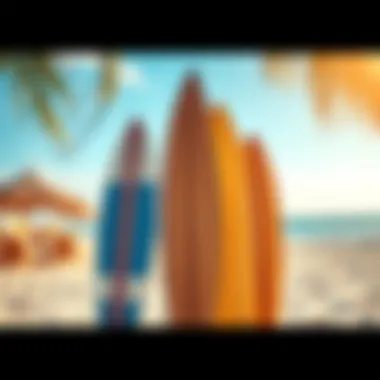

Intro
The world of surfing has always embraced creativity and innovation, but in recent years, there's been a delightful twist on what it means to surf and how one connects with the ocean. Enter cardboard surfboard cutouts. This fascinating development is revolutionizing how both novices and seasoned surfers express their unique personalities while simultaneously promoting sustainability. These cutouts not only serve as playful depictions of traditional surfboards but also foster a deeper understanding of surf culture among all ages.
As we dive into cardboard surfboard cutouts, we’ll explore their educational benefits, artistic applications, and the broader implications for surfer communities. With the rise of environmental concerns, this innovative approach speaks volumes about adapting our passions without compromising the planet. So, let’s paddle right in!
Surfing Techniques
Beginner Tips for Getting Started
When it comes to surfing, understanding the basics can be daunting, yet cardboard cutouts offer a relaxed environment for beginners to learn. Here are some handy tips:
- Start Small: Focus on mastering balance. Cardboard surfboard cutouts are lightweight, making them an excellent choice for practicing stances on dry land before hitting the waves.
- Foot Placement: Ensure your feet are placed shoulder-width apart. Utilizing a cutout can give beginners the visual help they need to understand proper spacing and alignment.
- Practice Paddling: Before taking to the water, get comfortable with the paddling motion. Sit on the cardboard cutout and mimic the paddling technique to build muscle memory.
Using cutouts as a visual aid, new surfers can playfully engage with the dynamics of surfing without the pressure of the ocean's waves.
Advaced Maneuvers and Tricks
For those who have already cut their teeth on the surfboard, incorporating cardboard cutouts into training routines can offer ingenious ways to refine skills. Here are some advanced maneuvers:
- 360 Spins: Practicing aerial maneuvers on a cardboard surfboard allows researchers to mimic body positioning and balance needed for these skills.
- Carves and Turns: Use the cutout to visualize turns while standing on it in surf-inclined stances, making muscle memory for getting low during real turns more instinctual.
- Shuvits: This trick requires swift foot movements. Using a cardboard cutout to rehearse foot placements can make executing this trick much smoother when you take it to the surf.
Mastering advanced moves not only builds confidence but also refreshes one's technique when they return to the water.
The Role of Cardboard Cutouts in Surf Culture
Artistic Expression and Community Building
The cardboard surfboard cutouts have blossomed into a form of artistic expression that transcends generations. From schools to workshops, communities engage with these cutouts to share stories, experiences, and creativity.
- Art Installations: Artists create stunning mural-sized cutouts that depict local waves or surf culture history, inviting the public to appreciate the artistic side of surfing.
- Workshops: Local surfing schools often host workshops where enthusiasts of all ages can get together to craft their own cutouts, forging connections and fostering camaraderie.
"Cutouts open doors to creativity; it's about more than surfing, it’s about creating a community around our love for the ocean."
These initiatives emphasize local identity and continuity of surfing culture while being fun for everyone involved.
Sustainability Aspect
Environmentally, cardboard offers a sustainable alternative to traditional materials used in surfboard design. Here are a few reasons why that matters:
- Renewable Resource: Cardboard is made from recyclable materials. Using it for surfboards highlights a shift towards greener choices in the surfing community.
- Reduced Carbon Footprint: Creating surfboards from cardboard lessens environmental impact, allowing surfers to maintain their love for the ocean without harming it.
By honoring sustainability, surfers express their commitment to protecting the natural resources they cherish.
Epilogue
Exploring cardboard surfboard cutouts offers a multifaceted perspective on surf culture. These cutouts combine creativity, education, and sustainability, bridging the gap between tradition and innovation. Through cardboard, not only do surfers engage with their art and the environment, but they also forge stronger community ties. In the ever-evolving surfing landscape, standing on a cardboard cutout might just be the next wave for artistic expression and environmental responsibility.
For further insights and resources on surfing culture, you can visit Wikipedia or dive into dedicated forums such as Reddit Surfing. Also, check out Britannica for a deeper understanding of this fascinating lifestyle.
Prelims to Cardboard Surfboard Cutouts
Cardboard surfboard cutouts are not just a quirky trend; they represent a fascinating blend of innovation and tradition within the surfing culture. With global concerns about environmental sustainability on the rise, these cutouts have emerged as a symbol of creative expression while also prompting discussions about responsible practices in surfboard construction. By utilizing materials that are often overlooked, we open doors to new possibilities that resonate with both seasoned surfers and newcomers alike.
The relevance of cardboard surfboard cutouts goes beyond just being an artistic endeavor or educational tool; they serve as a tangible reflection of the community's shift towards embracing eco-friendly paradigms. Through the lenses of creativity and environmental consciousness, it becomes important to explore what these cardboard creations mean for the surf culture, how they can be adapted for teaching purposes, and the artistic interpretations they inspire.
Defining Cardboard Surfboard Cutouts
Simply put, cardboard surfboard cutouts are crafted models or representations of surfboards made primarily from cardboard. They can serve a variety of purposes: educational tools for beginners, creative projects for artists, or even as props for community events. Unlike traditional surfboards, these cutouts can be created by anyone with basic materials, thus making the idea of surfing more accessible.
These cutouts often mimic the shapes and styles of real surfboards yet possess an unmistakable charm that comes from their amateur construction. Whether painted or adorned with creative designs, cardboard surfboard cutouts offer a unique way to express individuality and imagination within the surfing community. They can be used in various settings, from classrooms to art museums, making them a versatile addition to surf culture.
The Emergence of Cardboard in Surf Culture
In recent years, the emergence of cardboard surfboard cutouts can be traced back to a growing desire among surfers and artists to challenge the norm. As concerns about plastic waste and environmentally harmful manufacturing practices gain traction, cardboard has been a surprising yet worthy alternative. This transition represents a broader movement within surf culture striving to align with eco-conscious practices.
More and more, hands-on workshops and community projects are integrating cardboard cutouts into their curricula. They represent a way to inspire new generations of surfers to think about their impact on the world and cultivate a sense of responsibility towards ocean conservation. Additionally, these cutouts can engage individuals in discussions about traditional craftsmanship versus modern manufacturing, highlighting the artistic aspects of surf culture while also educating about ecological issues.
The adaptability of cardboard in surf culture is evident, as various local artist collectives and schools have begun to embrace these cutouts, incorporating them into larger projects that pay homage to the traditional elements of surfing while also paving the way for future innovations. Thus, cardboard surfboard cutouts are becoming a central element in the ongoing narrative of surfing, where creativity meets sustainability.
Historical Context of Surfboard Construction
The evolution of surfboard construction highlights a fascinating journey through materials and techniques that mirror cultural shifts in the surfing community. Understanding this historical context sheds light on the emergence of innovative concepts like cardboard surfboard cutouts. By examining how surfboards have developed over time, we can appreciate the creativity and sustainability efforts that reflect current surfing values. This section emphasizes the importance of historical insights, illustrating how past practices influence modern approaches in both craftsmanship and environmental consciousness.
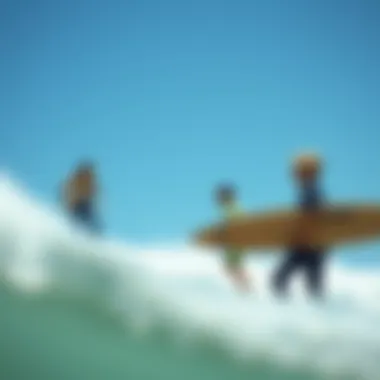
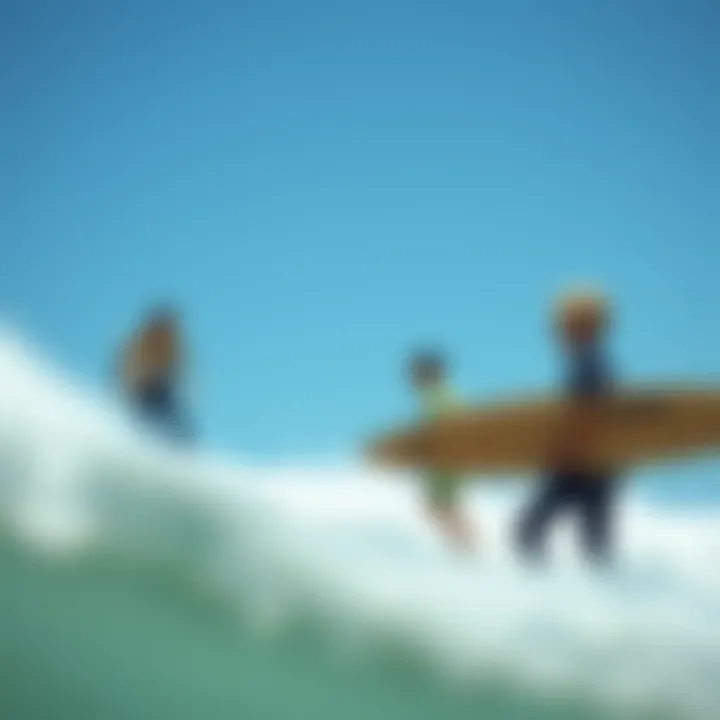
Evolution of Surfboard Materials
Wooden boards
Wooden boards were among the earliest surfboards, mostly crafted from various types of timber. The choice of wood like balsa or redwood an important aspect of these early designs; their natural buoyancy made them an excellent option for surfers. A key characteristic of wooden boards is their handcrafted nature, lending a uniqueness to each ride. They symbolize the roots of surf culture, being simple yet effective.
However, wooden boards do have some downsides. They tend to be heavier than modern materials and can absorb water, which affects their durability and performance. Overall, their organic appeal, comfort in paddling, and smooth gliding on waves solidified their place in surf history while paving the way for innovations.
Fiberglass innovations
The shift to fiberglass in the mid-20th century marked a significant turning point in surfboard production. Fiberglass boards are lightweight yet ruggedly strong, providing a dynamic performance that wooden boards simply couldn't match. A vital characteristic of fiberglass innovations is their capability to be molded into various shapes, allowing shapers to experiment with designs. This adaptability leads to optimized hydrodynamics, empowering surfers to tackle more challenging waves with confidence.
Despite their benefits, the production of fiberglass surfboards has raised environmental concerns, prompting a search for better solutions. The flip side of fiberglass is its reliance on synthetic materials which don’t decompose easily, creating waste issues further down the line. However, the innovations captured the imagination of many surfers, drastically influencing the performance and aesthetics of surfboards.
Transition to eco-friendly materials
As environmental awareness has risen, so has the shift towards eco-friendly materials in surfboard construction. Options like hemp, recycled plastics, and bio-resins represent this important aspect of modern surf culture. A highlight of transitioning to eco-friendly materials is the dedication to sustainability, ensuring that new surf production leaves a lighter footprint on the planet.
The unique feature of these materials is their ability to decompose or be recycled, reducing pressure on landfills. While the performance might not be at par with traditional fiberglass, the growing acceptance of eco-friendly boards indicates a change in priorities among surfers. Embracing these options highlights a communal commitment to protecting the oceans, thus enriching the cultural narrative of surfing.
Environmental Concerns in Surfboard Production
The introduction of new materials, while exciting, does not come without its share of challenges. Environmental concerns linger in surfboard production, dictating a careful balancing act between performance and sustainability. The rapid growth of the surf industry has led to increased demand for materials that often contribute to pollution and waste.
These concerns force the surfing community to reevaluate what crafting surfboards means and challenge both manufacturers and consumers to seek solutions that honor the oceanic ecosystem. By recognizing these environmental implications, we can understand the significance of innovations like cardboard surfboard cutouts in mitigating such issues.
Crafting Cardboard Surfboard Cutouts
Crafting cardboard surfboard cutouts is more than just a whimsical project; it serves as a practical gateway into the world of surfing. These cutouts provide an approach to learn surf techniques, enhancing both creativity and appreciation for ocean life. Additionally, they promote awareness regarding sustainable practices within the surf community. The artistry involved adds layers to the experience, making it accessible for novices and seasoned surfers alike.
Materials Required
To start your journey in crafting cardboard surfboard cutouts, having the right materials is essential. The most common material, of course, is cardboard itself—preferably a sturdy type, like that used in shipping boxes.
Here’s a brief list of necessary materials:
- Cardboard: A few large sheets would suffice.
- Utility knife or scissors: For precise cutting.
- Ruler and pencil: To measure and draw your design accurately.
- Paint or markers: For decorating the cutout.
- Glue, tape, or staples: To secure pieces together if you choose multi-layer designs.
Each of these materials plays its role in ensuring that the final product is both visually appealing and structurally sound.
Step-by-Step Guide to Creation
Creating a cardboard surfboard cutout doesn't have to be daunting. This simple guide breaks it down into manageable steps.
Designing the template
The foundation of your cutout lies in a well-thought-out template. Start by sketching your vision on paper before transferring it to the cardboard. This step is crucial because it ensures that all dimensions balance out properly.
The key characteristic of this stage is the significance of scale; a template that's too small or too large can throw off the whole project. Visualizing your cutout on a surface can prevent unnecessary puzzlement later on.
An advantage here is the room for creativity. You can design anything from a classic shortboard to a longboard shape. However, bear in mind that intricate designs may complicate the cutting process.
Cutting techniques
Once your template is ready, it’s time for the hands-on work. A utility knife is generally favored for cutting cardboard, allowing for clean edges compared to scissors. The importance of accurate cuts can't be overstated; it affects how well your pieces fit together in the end.
A notable feature of this technique is the ability to create curves, encouraging an understanding of surfboard shape benefits. Poor cuts can lead to frustration, so using a straightedge will help maintain control. While cutting is indeed straightforward, it does require patience and some practice to perfect.
Finishing touches
When your cuts are made, the last phase is adding personality. Decorative techniques, like painting or drawing on your cutout, are where the fun really kicks in. This aspect not only beautifies the cutout but also deepens the connection with surf culture.
A compelling characteristic of this final stage is the opportunity to express individuality. While some might prefer bold patterns, others may lean toward minimalist designs. The unique feature of adding touches of personality often results in an emotional attachment to the craft. However, excess layering or decoration can sometimes make the cutout heavy and less functional, which is a balance you’ll want to consider.
By crafting these cutouts, enthusiasts gain a keener understanding of the art of surfing while connecting with environmental benefits.
In summary, crafting cardboard surfboard cutouts is more than just an artistic endeavor; it’s a meaningful exercise that promotes creativity, learning, and connection to the wider surf culture.
Educational Benefits of Cardboard Cutouts
Cardboard surfboard cutouts serve a multifaceted role in education, particularly within the surf culture framework. These creations provide an innovative medium, allowing aspiring surfers to learn and engage with key surfing concepts without the financial burden and risks associated with traditional board usage. More than just artistic expressions, these cutouts promote practical skills and conceptual understanding while fostering a sense of community among learners.
Teaching Surf Techniques


One of the primary educational advantages of cardboard cutouts is their effectiveness in teaching surf techniques. Beginners often struggle with the physical aspect of surfing. With cardboard cutouts, learners can practice various aspects of surfing in a safe environment. This includes understanding paddling positions, wave balance, and body posture necessary for standing on a surfboard.
- Practical Engagement: Using cardboard cutouts as physical models can illustrate techniques such as stance and balance. For instance, learners can be guided to simulate paddling and popping up on their cutouts before hitting the actual waves.
- Feedback Opportunities: These cutouts allow instructors to provide immediate corrective feedback. Whether it’s adjusting a student’s foot placement or their body angle, constructive criticism can be delivered efficiently.
- Inclusion of Visual Learning: Cardboard cutouts can be artistically decorated, demonstrating different surfing styles or tips. Adding visuals captures the attention of younger audiences, making learning not only educational but also enjoyable.
In summary, cardboard cutouts can transform the often intimidating learning curve of surfing into a straightforward and collaborative experience.
Encouraging Ocean Awareness
Beyond teaching surf techniques, cardboard cutouts play a vital role in fostering ocean awareness among surfers of all ages. They symbolize the connection between surfers and the marine environment, reminding users of the ecological responsibilities that accompany the sport.
- Environmental Education: Many surf schools utilize cardboard cutouts to highlight issues affecting oceans, such as pollution and conservation efforts. Workshops can incorporate discussions of marine ecosystems and the impact of human activity on these vital resources.
- Community Projects: Events driven by community engagement, like building massive cardboard cutout installations in public spaces, can be effective in educating participants about the surf culture's relationship with the ocean. This broadens participants' knowledge and instills a sense of pride and responsibility.
- Artistic Expression: When learners create their own cardboard cutouts, they engage in a narrative that connects their creativity with environmental issues. This artistic venture can lead to conversations about sustainability in surfing and ocean health, planting the seeds for future advocacy.
By integrating technological practices, the use of cardboard cutouts holds a unique place in surf education, where the classroom extends onto the ocean waves.
Artistic Applications of Cardboard Surfboard Cutouts
As we navigate the creative landscapes of surf culture, the role of cardboard surfboard cutouts emerges as something far beyond mere playthings. Each cutout becomes an avenue of expression, merging artistic ingenuity with traditional surfing ethos. They offer a unique medium for artists and surfers alike to communicate their passion for the waves and the environment, making them pivotal in transforming how we view surf artistry.
Use in Surf Art
Mixed media projects
Mixed media projects utilizing cardboard surfboard cutouts hold a special charm. They allow for a blend of textures and materials, enhancing depth and visual interest. In a world where artists regularly experiment with various forms, cardboard provides a lightweight yet sturdy base, making it a versatile choice. One notable characteristic of mixed media projects is their inherent adaptability; artists can integrate paint, fabric, and other materials, inviting creativity to flow freely.
These projects often reflect contemporary matters and meld personal stories with broader environmental themes, catering well to a conscientious audience. Emphasizing sustainability, mixed media on cardboard aligns with eco-friendly practices. However, one disadvantage might be the fragility of certain elements when combined, requiring careful handling during installation or transportation. Nevertheless, the creativity this approach fosters is often deemed worth the risk.
Exhibiting local artists
Exhibiting local artists' works that incorporate cardboard surfboard cutouts cultivates community spirit and showcases talent. This particular aspect of the art scene highlights the importance of regional narratives in surf culture. With the unique perspective of local creators, the exhibits often capture the essence of specific surfing locales, drawing in visitors and locals alike.
A significant characteristic of showing these artists is the communal engagement they inspire. Viewers are not just passive observers; they actively participate in discussions around the pieces and the stories behind them. This engagement can serve as a catalyst for collaboration among artists, shapers, and surfers, enriching the culture overall. While there may be limited exposure in broader art circles compared to well-established artists, the intimacy of community showcases creates a distinct and heartfelt atmosphere.
Creating Installations
Moving beyond individual pieces, cardboard surfboard cutouts can also form captivating installations that invite viewers to immerse themselves in the art. These installations can transform spaces, whether galleries, public parks, or local surf shops, creating a multifaceted dialogue about water, waves, and the surf lifestyle.
Special attention should be given to how these installations reflect both the joys and challenges of surfing, often addressing environmental issues and sustainability practices. The final presentation can shed light on the interplay between artistic expression and the love of the ocean.
To fully capitalize on the potential of cardboard cutouts, artists must consider the following:
- Visibility: Ensure that the installation is positioned to capture attention without overwhelming the surrounding space.
- Interactivity: Consider incorporating elements that engage the audience—maybe allowing them to walk through or interact with the cutouts.
- Educational component: If relevant, include information about the ecological impact of surfing or the specific techniques used in the cutouts, enriching the viewer's understanding.
In summation, the artistic applications of cardboard surfboard cutouts reflect a meaningful confluence of creativity, local culture, and sustainable practices. As artists leverage these cutouts, they not only showcase their work but also cultivate a richer conversation about surf culture and environmental awareness.
Cultural Impact of Cardboard Cutouts
Cardboard surfboard cutouts are more than just a playful nod to the sport; they echo the very spirit of surf culture, where creativity and community often ride the same wave. These cutouts symbolize a blend of artistic expression and practical application, infusing the surf scene with new life and inspiration.
Promoting Community Engagement
The surge of cardboard surfboard cutouts has ignited local communities and provided a platform for collaborative creativity. When individuals come together to craft and decorate these cutouts, they foster a unique sense of belonging. Picture a group of surfers assembling at a beach clean-up event, where alongside tackling the pressing issue of ocean pollution, they engage in creating cardboard replicas of their favorite boards. This duality of purpose not only raises awareness about environmental conservation but also strengthens social bonds among participants.
Moreover, art fairs and exhibitions centered around cardboard creations encourage even broader community interaction. Local artists are given the chance to display their innovative designs, effectively inviting surfers and non-surfers alike to appreciate the beauty of both surfing and creative expression. It becomes a platform for dialogue, where stories about experiences on the waves can be shared alongside those that come from the canvas of a cardboard cutout.
“Art, at its best, is a dialogue, and in surf culture, everyone has a voice.”
These events elevate the status of surf culture beyond the water's edge, transforming it into a vibrant community of activists and artists working hand-in-hand. By engaging in these activities, participants contribute to a culture that values creativity, solidarity, and sustainability.
Influencing Trends in Surf Culture
As cardboard surfboard cutouts carve their niche within surf culture, they herald fresh trends that combine artistry with functionality. The minimalist nature of cardboard challenges traditional aesthetics, encouraging surfers to think outside the usual boundaries of board design. These cutouts are not just child's play; they influence how surfers perceive their boards and their connection to the environment.
For instance, as more shapers experiment with eco-friendly materials like cardboard, there’s a growing emphasis on sustainability within the industry. The cardboard cutout movement is pushing against the grain of heavy plastics and harmful resins, inviting a revolution that ties surfing practices to greater ecological consciousness. In a way, these cutouts serve as a catalyst for critical conversations around sustainable practices in the design and production of surfboards.
Additionally, popularizing cardboard in surf arts can inspire the next wave of innovations. As each artist brings their unique flair to the table, trends like customization and personal expression gain momentum. The trend transcends simple reproduction of classic designs and allows for unprecedented creativity that can even involve collaborative artworks or community challenges focused on surf culture.
In essence, the cultural impact of cardboard surfboard cutouts ripples through the surf scene, fostering connections and trends that challenge norms, inspire sustainability, and promote vibrant community engagement—tenets that lie at the heart of surf culture.
Environmental Sustainability of Cardboard Options
When we think about surfing, often the image that comes to mind is a perfect wave and a sleek board, made of polished fiberglass or a vibrant wooden finish. However, the surf industry is gradually waking up to the reality that these materials can come with significant environmental footprints. This makes the emergence of cardboard surfboard cutouts not only an innovative twist on traditional surfing but also a necessary pivot towards sustainability. By examining the cardboard options available, we see a pathway to merge creativity with eco-consciousness.
Biodegradable Solutions
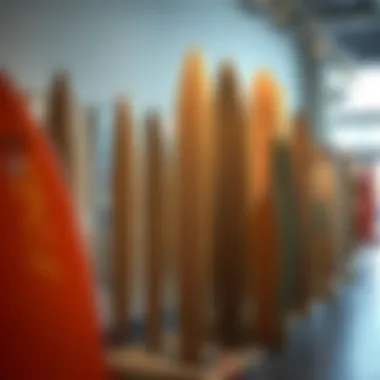
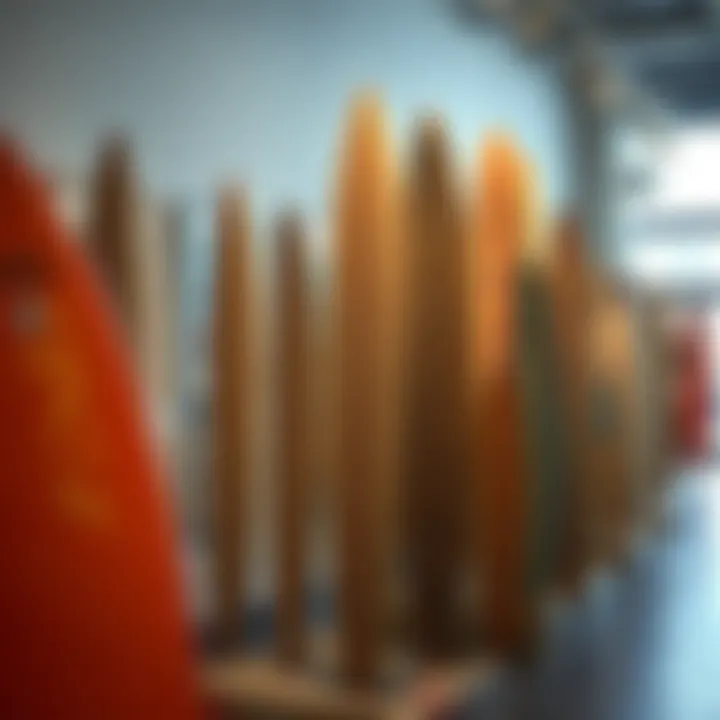
Using cardboard as a surfboard medium brings about the much-needed benefit of being biodegradable. Unlike synthetic materials that can take centuries to decompose, cardboard, derived from trees, can be broken down into natural elements in just a few months when exposed to natural conditions. This fact paints a stark contrast against the backdrop of our growing landfill crisis.
For surfers who care about the environment, these biodegradable cutouts offer a refreshing alternative that allows individuals to indulge their passion while minimizing their ecological footprint. They offer an opportunity to experience the thrill of crafting and using a surfboard that will return to the earth rather than remain a permanent fixture in a waste site.
By leaning into biodegradable options, manufacturers and surfers alike find ways to innovate without creating more waste. It's a clear win-win scenario, where creativity in board design meets environmental responsibility. An emerging community of surfers passionate about the ocean is recognizing that sustainability does not need to compromise performance or enjoyment; rather, it enhances the surfing experience.
Reducing Waste in Surf Industry
The surf industry, like many others, grapples with the dual challenge of consumer demand and waste generation. Cardboard cutouts provide a unique avenue to curb excess waste. Traditional surfboard manufacturing processes can involve a variety of materials and generate outsized amounts of leftover materials that end up discarded. Cardboard surfboards, however, are made using a straightforward approach, ensuring minimal waste during production.
Consider this:
- Cutting waste: Designing and creating cardboard boards can take advantage of precise cutting methods, allowing for almost every part of the cardboard to be utilized.
- Flexibility of design: Unlike traditional boards that require extensive tooling, cardboard can be cut and reshaped easily. Designs can be rethought and adapted to maximize material use, thus reducing scrap.
- Community workshops: Many local surf communities are already hosting workshops for making cardboard surfboards./ These events not only divvy up resources but also foster educational growth among participants, instilling eco-conscious practices right from the ground up.
In this atmosphere of collaboration and creativity, the reduction of waste becomes an organic outcome. Surfers can take pride in the knowledge that their creative expressions do not come at the cost of the planet. Instead, they are reshaping surf culture to highlight environmental stewardship, showcasing that a novel approach to surfboards can create waves of positive impact.
Challenges in Using Cardboard for Surfboards
When it comes to asserting cardboard surfboard cutouts in the realm of surf culture, we must first confront a few bumps on the road. Those keen on trying this innovative approach can run into specific obstacles that may hinder the overall experience. It's not merely about creating something that looks good; it’s about functionality and durability. After all, surfers spend considerable time riding the waves, and a board made of cardboard could create some hesitation. Here, we’ll dive into some practical challenges that need attention as we explore what cardboard can really bring to the table.
Durability Issues
One of the first hurdles is durability—or rather, the lack thereof. Unlike traditional surfboards made from fiberglass or foam, cardboard doesn’t have the same weatherproofing. Water can be a relentless enemy. A cardboard surfboard may buckle, warp, or even crumble when faced with the salty sea or sudden downpours. Surfers need their boards to withstand crashes and heavy use while catching waves, and it’s hard to trust a material that might soak and fall apart.
"A cardboard board might seem like a fun novelty, but once it hits the water, the laughter might quickly turn into frustration."
Moreover, UV exposure can play its part too. The sun can easily degrade cardboard materials, weakening its already flimsy presence. A cardboard board may require additional treatments or coatings to offer some level of protection. This brings us to the question of additional costs and time commitment, which can quickly overshadow the sheer fun of experimentation.
Performance Comparisons with Traditional Boards
Another angle to consider is performance when stacked against the tried-and-true surfboards. Traditional boards are designed with specific materials to ensure optimal hydrodynamic properties. Cardboard, while lightweight, offers no such assurances. Maneuverability can be suspect at best, potentially leaving a surfer feeling like they are riding a less precise board.
The buoyancy factor must also enter the conversation. It's not just about staying afloat but about how well a board can glide through water. Some cardboard versions may struggle to keep a surfer riding high on the waves, leading to a less enjoyable experience. In the competitive world of surfing performance, anything less than spectacular can send a wannabe surfer back to the drawing board.
Nonetheless, it’s important to recognize that performance doesn't always hinge on high-tech materials. For example, many minimalists find joy in riding foam boards for their simplicity and maneuverability. Still, without the assurance that cardboard can pull off comparable tricks, many surfers might cautiously sidestep it for more reliable options.
Future Perspectives on Cardboard Surfboard Cutouts
The horizon for cardboard surfboard cutouts is broadening, presenting various opportunities for innovation and collaboration within the surf culture sphere. As the community becomes more mindful of environmental dynamics, cardboard surfboards serve as a significant asset, marrying creativity with sustainability. Shapers and artists stand at the forefront of this evolution, ready to influence the next generation of surf culture.
In the realm of surf culture that traditionally leans toward the use of high-tech materials, integrating cardboard surfboards presents a refreshing narrative. It challenges the norms while emphasizing ecological responsibilities. Cardboard cutouts are not just crafts; they encapsulate the spirit of adventure and experimentation, opening pathways for practical implementation in various realms, from education to art.
Technological Innovations
As technology continues to advance, the processes used to create cardboard surfboard cutouts can greatly benefit. Innovations such as digital design tools empower artists to craft highly detailed templates that can be precisely replicated. 3D printing technology, for instance, can also contribute by allowing for the creation of customized fin systems or accessories that enhance a cardboard board's functionality.
Such technological augmentation doesn’t stop at the design phase. Improvements in waterproofing methods specific to cardboard boards can lead to enhanced durability and performance. Moreover, research into treated cardboard materials could yield boards that withstand the elements more effectively, creating a sensational blend of sustainability with performance efficiency.
Benefits of Technological Improvements:
- Enhanced customization options for surfers.
- Greater adaptability to varied surf conditions.
- Increased marketability with innovative designs.
Potential for Collaboration Among Artists and Shapers
The blend of artistic expression and surf craftsmanship opens a tantalizing prospect. Artists can collaborate with professional shapers to develop unique designs that visually and functionally revolutionize the standard board. This collaboration could lead to events showcasing dual talents—for instance, an exhibition where artists present their designs as functional surfboards, enticing both art aficionados and surf enthusiasts.
Furthermore, community initiatives can be generated that involve local talents in workshops aimed at creating these cutouts. Such engagements can ignite the interest among younger demographics, marrying art education with practical skills and elevating surf culture through creative avenues.
"Through collaboration, artists and shapers bridge disciplines, crafting a unique language that speaks to sustainability, creativity, and tradition."
The conversation around cardboard surfboards is still nascent. However, as the community rallies around innovative practices and sustainability, the future looks promising. Engaging with technology and fostering collaboration may just carve out a new niche in surf culture that honors the ocean while encouraging an artistic renaissance.
By recognizing these future perspectives, the surfing community can enrich its cultural heritage while simultaneously embracing the changing tides of our environmental responsibilities.
Culmination: The Role of Cardboard in Shaping Surf Culture
As we near the end of our exploration, it's crucial to reflect on the multifaceted role that cardboard surfboard cutouts play in surf culture. This innovative approach not only embodies creativity but also marries sustainability with tradition. With increasing environmental concerns, cardboard surfboards stand out as a reminder that cultural practices can evolve while maintaining respect for nature. This intersection of art, education, and eco-friendliness makes a compelling case for their use in both practical and artistic realms.
One of the most significant aspects of cardboard cutouts is their accessibility. They encourage participation from all corners of the surfing community—whether it’s seasoned surfers introducing the art form to novices or educators using them as instructional materials for schools. The simplicity of cardboard allows it to transcend barriers, creating a space for everyone to engage in surf culture.
Moreover, as the surfing world keeps changing, the role of cardboard surfboards as a canvas for artists speaks volumes. This medium challenges the conventions of traditional surfing gear, offering individuals a chance to express their thoughts, feelings, and visions. Carving a cardboard surfboard is almost like sculpting with memories of the waves, making each piece unique.
“Creativity knows no bounds; cardboard surfboards push the limits of what we think is possible in surf culture.”
As more surfers and artists embrace this innovative approach, we can expect to see an ongoing dialogue about the balance between environment and enjoyment within the surf community. Cardboard surfboard cutouts are more than just tools; they are a catalyst for conversation, action, and change in how we perceive surf culture.
Wrapping Up the Discussion
Invitation for Further Exploration
As we finish this discussion, the door is wide open for further exploration into the world of cardboard surfboard cutouts. Whether you're a seasoned surfboard shaper or a curious beachcomber, diving deeper into this topic can lead to remarkable discoveries. Consider trying your hand at crafting a cardboard cutout; join local workshops or engage in community art projects focused on surf culture. The more people who explore this medium, the richer the dialogue around sustainability and artistic expression in surfing will become. Check out platforms like Reddit and Facebook for community projects and discussions about cardboard cutouts. Surf culture is evolving, and you could be at the forefront of this wave.



